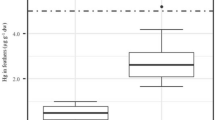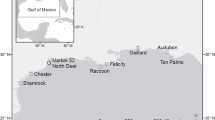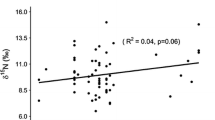Abstract
The Derwent estuary, in south east Tasmania, is highly contaminated with heavy metals, mainly due to past industrial pollution. This study sought to determine the extent of contamination, bioaccumulation, and biomagnification in the resident bird community and therefore to infer the potential for adverse effects in birds. Thirteen metals were measured from breast feathers (n = 51 individuals) of eight sympatric species of aquatic bird. Stable carbon (δ13C) and nitrogen (δ15N) isotopes were used to identify dietary sources of contaminants, trophic level, and potential biomagnification through food chains. Generalised linear models revealed that metal burdens were often poorly correlated with δ 13C, indicating their uptake from a range of freshwater, brackish, and marine carbon sources—not surprising due to widespread contamination across the tidal estuary. Feather mercury increased significantly with trophic level (inferred from δ15N). White-bellied Sea-eagle Haliaeetus leucogaster samples contained 240 times more mercury than feral Goose Anser cygnoides. Feather arsenic and copper concentrations were significantly higher in birds feeding lower in the food chain. For several piscivorous species, both chick and adults were sampled revealing significantly higher feather mercury, zinc, and selenium in adults. Feathers from birds found dead along the banks of the estuary had significantly higher lead loads than from live birds, and numerous individuals had levels of mercury, zinc, and lead above toxic thresholds reported in other studies. These results highlight the need to include biota from higher trophic levels in contaminant monitoring programs to understand fully the fate and broader implications of contaminants in the environment.





Similar content being viewed by others
References
Aazami J, Esmaili-Sari A, Bahramifar N, Ghasempouri M, Savabieasfahani M (2011) Mercury in liver, kidney, feather and muscle of seabirds from major wetlands of the Caspian Sea, Iran. Bull Environ Contam Toxicol 86:657–661
Abdullah M, Fasola M, Muhammad A, Malik SA, Bostan N, Bokhari H, Kamran MA, Shafqat MN, Alamdar A, Khan M, Ali N (2015) Avian feathers as a non-destructive bio-monitoring tool of trace metals signatures: a case study from severely contaminated areas. Chemosphere 119:553–561
Ackerman JT, Eagles-Smith CA (2009) Selenium bioaccumulation and body condition in shorebirds and terns breeding in San Francisco Bay, California, USA. Environ Toxicol Chem 28:2134–2141
Agusa T, Matsumoto T, Ikemoto T, Anan Y, Kubuto R, Yasunaga G, Kunito T, Tanabe S, Ogl H, Shibata Y (2005) Body distribution of trace elements in black-tailed gulls from Rishiri Island, Japan: age-dependent accumulation and transfer to feathers and eggs. Environ Toxicol Chem 24:2107–2120
Barwick M, Maher W (2003) Biotransference and biomagnifications of selenium, cadmium, zinc, arsenic and lead in a temperate seagrass ecosystem from Lake Macquarie Estuary, NSW, Australia. Mar Environ Res 56:471–502
Bearhop S, Waldron S, Thompson D, Furness R (2000) Bioamplification of mercury in Great Skua Catharacta skua chicks: the influence of trophic status as determined by stable isotope signatures of feathers. Mar Pollut Bull 40:181–185
Becker PH, Furness RW, Henning D (1993) Hg dynamics in young Common Tern Sterna hirundo chicks from a polluted environment. Ecotoxicology 2:33–40
Becker PH, Gonzàlez-solìs J, Behrends B, Croxall J (2002) Feather mercury levels in seabirds at South Georgia: influence of trophic position, sex and age. Mar Ecol Prog Ser 243:261–269
Beyer WN, Dalgarn J, Dudding S, French JB, Meteo R, Miesner J, Sileo L, Spann J (2004) Zinc and lead poisoning in wild birds in the Tri-State Mining District (Oklahoma, Kansas, and Missouri). Arch Environ Contam Toxicol 48:108–117
Bi X, Feng X, Yang Y, Qiu G, Li G, Li F, Liu T, Fu Z, ** Z (2006) Environmental contamination of heavy metals from zinc smelting areas in Hezhang County, western Guizhou, China. Environ Int 32:883–890
Bilney RJ, Emison WB (1983) Breeding of the white-bellied sea-eagle in the Gippsland Lakes Region of Victoria, Australia. Aust Birdwatcher 10:61–68
Blévin P, Carravieri A, Jaeger A, Chastel O, Bustamante P, Cherel Y (2013) Wide range of mercury contamination in chicks of Southern Ocean seabirds. PLoS ONE 8(1):e54508. https://doi.org/10.1371/journal.pone.0054508
Bloom H, Ayling GM (1977) Heavy metals in the Derwent Estuary. Environ Geol 2:3–22
Blus LJ, Henny CJ, Hoffman DJ, Grove RA (1991) Lead toxicosis in tundra swans near a mining and smelting complex in northern Idaho. Arch Environ Contam Toxicol 21:549–555
Bolker BM (2008) Ecological models and data in R. Princeton University Press, New Jersey
Bond AL, Diamond AW (2008) High within-individual variation in total Hg concentration in seabird feathers. Environ Toxicol Chem 27:2375–2377
Bond AL, Diamond AW (2009) Total and methyl mercury concentrations in seabird feathers and eggs. Arch Environ Contam Toxicol 56:286–291
Bond AL, Lavers JL (2011) Trace element concentrations in feathers of Flesh-footed Shearwaters (Puffinus carneipes) from across their breeding range. Arch Environ Contam Toxicol 61:318–326
Bond JC, Esler D, Hobson KA (2007) Isotopic evidence for sources of nutrients allocated to clutch formation by Harlequin Ducks. Condor 109:698–704
Brasso RL, Polito MJ, Emslie SD (2014) Multi-tissue analyses reveal limited inter-annual and seasonal variation in mercury exposure in an Antarctic penguin community. Ecotoxicology 23:1494–1504
Burger J (1993) Metals in avian feathers: bioindicators of environmental pollution. Rev Environ Toxicol 5:203–311
Burger J, Gochfeld M (1993) Heavy metal and selenium levels in feathers of young egrets and herons from Hong Kong and Szechuan, China. Arch Environ Contam Toxicol 25:322–327
Burger J, Gochfeld M (1997) Risk, Hg levels, and birds: relating adverse laboratory effects to field biomonitoring. Environ Res 75:160–172
Burger J, Gochfeld M (2000a) Effects of lead on larids: a review of laboratory and field studies. J Toxicol Environ Health 3:59–78
Burger J, Gochfeld M (2000b) Metal levels in feathers of 12 species of seabirds from Midway Atoll in the northern Pacific Ocean. Sci Tot Environ 257:37–52
Burger J, Schreiber EAE, Gochfeld M (1992) Lead, cadmium, selenium and mercury in seabird feathers from the tropical mid-Pacific. Environ Toxicol Chem 11:815–822
Calle P, Alvarado O, Monserrate L, Cevallos JM, Calle N, Alva JJ (2015) Mercury accumulation in sediments and seabird feathers from the Antarctic Peninsula. Mar Pollut B 91:410–417
Cardwell RD, DeForest DK, Brix KV, Adams WJ (2015) Do Cd, Cu, Ni, Pb, and Zn biomagnify in aquatic ecosystems? In: Whitacre DM (ed) Reviews of environmental contamination and toxicology, vol 226. Springer, New York, pp 101–122
Carvalho PC, Bugoni L, McGill RAR, Bianchini A (2013) Metal and selenium concentrations in the blood and feathers of petrels in the genus Procellaria. Environ Toxicol Chem 32:1641–1648
Cheung MS, Wang W (2008) Analyzing biomagnification of metals in different marine food webs using nitrogen isotopes. Mar Pollut B 56:2082–2105
Coughanowr C, Whitehead S, Whitehead J, Einoder L, Taylor U, Weeding B (2015) State of the Derwent estuary: a review of environmental data from 2009 to 2014. Derwent Estuary Program, Hobart
Dauwea T, Bervoetsb L, Pinxtena R, Blustb R, Eens M (2003) Variation of heavy metals within and among feathers of birds of prey: effects of molt and external contamination. Environ Pollut 124:429–436
de Winter JCF (2013) Using the student’s t-test with extremely small sample sizes. PARE 18:1–10
Dormann CF, Elith J, Bacher S, Buchmann C, Carl G, Carré G, García Marquéz JR, Gruber B, Lafourcade B, Leitão PJ, Münkemüller T, McClean C, Osborne PE, Reineking B, Schröder B, Skidmore AK, Zurell D, Lautenbach S (2013) Collinearity: a review of methods to deal with it and a simulation study evaluating their performance. Ecography 35:1–20
Eagles-Smith CA, Ackerman JT, De La Cruz SEW, Takekawa JY (2009) Mercury bioaccumulation and risk to three waterbird foraging guilds is influenced by foraging ecology and breeding stage. Environ Pollut 157:1993–2202
Eagles-Smith CA, Wiener JG, Eckley CS, Willacker JJ, Evers DC, Marvin-DiPasquale M, Obrist D, Fleck JA, Aiken GR, Lepak JM, Jackson AK, Webster JP, Stewart AR, Davis JA, Alpers CN, Ackerman T (2016) Mercury in western North America: a synthesis of environmental contamination, fluxes, bioaccumulation, and risk to fish and wildlife. Sci Tot Environ 568:1213–1226
Elliott JE (2005) Trace metals, stable isotope ratios, and trophic relations in seabirds from the North Pacific Ocean. Environ Toxicol Chem 24:3099–3105
Elliott JE, Elliot KH (2013) Tracking marine pollution. Science 340:556–558
Evers DC, Mason RP, Kamman NC, Chen CY, Bogomolni AL, Taylor DL, Hammerschmidt CR, Jones SH, Burgess NM, Munney K, Parson KC (2008) An integrated mercury monitoring program for temperate estuarine and marine ecosystems on the North American Atlantic Coast. EcoHealth 4:426–441
Frederick PC, Spalding MG, Dusek R (2002) Wading birds as bioindicators of mercury contamination in Florida, USA: annual and geographic variation. Environ Toxicol Chem 21:163–167
Furness RW (1993) Birds as monitors of pollutants. In: Furness RW, Greenwood JJD (eds) Birds as monitors of the environmental change. Chapman and Hall, London, pp 86–133
Galluzzi PF (1981) Mercury concentrations in mammals, reptiles, birds, and waterfowl collected in the Hackensack Meadowlands, New Jersey. New Jersey academy of science annual meeting, March 28, 1981
Gasaway WC, Buss IO (1972) Zinc toxicity in the mallard duck. J Wildl Manag 36:1107–1117
Goede AA (1985) Mercury, selenium, arsenic and zinc in waders from the Dutch Wadden Sea. Environ Pollut A 37:287–309
Goede AA, De Bruin M (1986) The use of bird feathers for indicating heavy metal pollution. Environ Monit Assess 7:249–256
Golden NH, Rattner BA, McGowan PC, Parsons KC, Ottinger MA (2003) Concentrations of metals in feathers and blood of nestling Black-Crowned Night-Herons Nycticorax nycticorax in Chesapeake and Delaware Bays. B Environ Contam Toxicol 70:385–393
Henny CJ, Blus LJ, Hoffman DJ, Grove RA, Hatfield JS (1991) Lead Accumulation and Osprey production near a mining site on the Coeur d’Alene River, Idaho. Arch Environ Contam Toxicol 21:415–424
Hoskins AJ, Dann P, Ropert-Coudert Y, Kato A, Chiaradia A, Costa DP, Arnould JPY (2008) Foraging behaviour and habitat selection of the little penguin Eudyptula minor during early chick rearing in Bass Strait, Australia. Mar Ecol Prog Ser 366:293–303
Jæger I, Hop H, Gabrielsen GW (2009) Biomagnification of mercury in selected species from an Arctic marine food web in Svalbard. Sci Tot Environ 407:4744–4751
Jones H, Swadling K, Butler E, Macleod C (2013) Spatial variability in selenium and mercury interactions in a key recreational fish species: implications for human health and environmental monitoring. Mar Pollut B 74:231–236
Kalisináska E, Salicki W, Mysłek P, Kavetska KM, Jackowski A (2004) Using the Mallard to biomonitor heavy metal contamination of wetlands in north-western Poland. Sci Tot Environ 320:145–161
Kehrig HA, Seixas TG, Malm O, Di Beneditto APM, Rezende CE (2013) Mercury and selenium biomagnification in a Brazilian coastal food web using nitrogen stable isotope analysis: a case study in an area under the influence of the Paraiba do Sul River plume. Mar Pollut B 75:283–290
Ko HT (2011) Metal bioaccumulation of New Zealand half-crab, Petrolisthes elongatus in the Derwent Estuary. Hons Thesis, University of Tasmania, Tasmania
Labbé AMT, Dunlop JN, Loneragan NR (2013) Central place foraging and feather regrowth rate in bridled terns (Onychoprion anaethetus): an insight from stable isotopes. Mar Freshwater Res 64:1184–1191
Li G, Feng X, Qui G, Bi X, Li Z, Zhang C, Wang D, Shang L, Guo Y (2008) Environmental mercury contamination of an artisanal zinc smelting area in Weining County, Guizhou, China. Environ Pollut 154:21–31
Lodenius M, Solonen T (2013) The use of feathers of birds of prey as indicators of metal pollution. Ecotoxicology 22:1319–1334
Lourdes MA, Cuvin-Aralar A, Furness RW (1991) Mercury and selenium interaction: a review. Ecotoxicol Environ Safe 21:348–364
Lucia M, Bocher P, Chambosse M, Delaporte P, Bustamante P (2014) Trace element accumulation in relation to trophic niches of shorebirds using intertidal mudflats. J Sea Res 92:134–143
Lyver POB, Aldridge SP, Gormley AM, Gaw S, Webb S, Butwon RT, Jones CL (2017) Elevated mercury concentrations in the feathers of Grey-faced Petrels (Pterodroma gouldi) in New Zealand. Mar Pollut Bull 119:195–203
Malinga M, Szefer P, Gabrielsen GW (2010) Age, sex and spatial dependent variations in heavy metal levels in Glaucous Gulls (Larus hyperboreus) from the Bjornoya and Jen Mayen, Arctic. Environ Monit Assess 169:407–416
Markowski M, Banbura M, Kalinski A, Markowski J, Skwarska J, Zielinski P, Wawrzyniak J, Ban J (2013) Avian feathers as bioindicators of the exposure to heavy metal contamination of food. B Environ Contam Toxicol 91:302–305
Metcheva R, Yurukova L, Teodorova S, Nikolova E (2006) The penguin feathers as bioindicator of Antarctica environmental state. Sci Total Environ 362:259–265
Ohlendorf HM, Heinz GH (2011) Selenium in Birds. In: Nelson Beyer W, Meador JP (eds) Environmental contaminants in biota: interpreting tissue concentrations, 2nd edn. CRC Press, Boca Raton, pp 669–696
Outridge PM, Scheuhammer AM (1993) Bioaccumulation and toxicology of nickel: implications for wild mammals and birds. Environ Rev 1:172–197
Peterson BJ (1999) Stable isotopes as tracers of organic matter input and transfer in benthic food webs: a review. Acta Oecol 20:479–487
Rahman MA, Hasegawa H, Lim RP (2012) Bioaccumulation, biotransformation and trophic transfer of arsenic in the aquatic food chain. Environ Res 116:118–135
Rattner BA, Golden NH, Toschik PC, McGowan PC, Custer TW (2008) Concentrations of metals in blood and feathers of nestling ospreys (Pandion haliaetus) in Chesapeake and Delaware Bays. Arch Environ Contam Toxicol 54:114–122
R Core Team (2017) R: a language and environment for statistical computing. R Foundation for Statistical Computing, Vienna, Austria. https://www.R-project.org/
Scheuhammer AM (1987) The chronic toxicity of aluminium, cadmium, Hg and lead in birds: a review. Environ Pollut 46:263–295
Scheuhammer AM, Meyer MW, Sanderheinrich MB, Murray MW (2007) Effects of environmental methylmercury on the health of wild birds, mammals, and fish. Ambio 36:12–19
Senn DB, Chesney EJ, Blum JD, Bank MS, Maage A, Shine JP (2010) Stable isotope (N, C, Hg) study of methylmercury sources and trophic transfer in the northern Gulf of Mexico. Environ Sci Technol 44:1630–1637
Squadrone S, Abete MC, Brizio P, Monaco G, Colussi S, Biolatti C, Modesto P, Acutis L, Pessani D, Favaro L (2016) Sex- and age-related variation 5 in metal content of penguin feathers. Ecotoxicology 25:431–438
Tsipoura N, Burger J, Newhouse M, Jeitner C, Gochfeld M, Mizrahi D (2011) Lead, mercury, cadmium, chromium, and arsenic levels in eggs, feathers, and tissues of Canada geese of the New Jersey Meadowlands. Environ Res 111:775–784
Vanderklift MA, Ponsard S (2003) Sources of variation in consumer-diet d15 N enrichment: a meta-analysis. Oecologia 136:169–182
Veerle J, Dauwe T, Pinxten R, Bervoets L, Blust R, Eens M (2004) The importance of exogenous contamination on heavy metal levels in bird feathers. A field experiment with free-living great tits, Parus major. J Environ Monitor 6:356–360
Verdouw JJ, Macleod CK, Nowak BF, Lyle JM (2010) Implications of age, size and region on mercury contamination in estuarine fish species. Water Air Soil Pollut 214:297–306
Zamani-Ahmadmahmoodi R, Esmaili-Sari A, Savabieasfahani M (2010) Cattle egret (Bubulcus ibis) and Little egret (Egretta garzetta) as monitors of mercury contamination in Shadegan Wetlands in south-western Iran. Environ Monit Assess 166:371–377
Zhang Y, Raun L, Fasola M, Boncomagni E, Dong Y, Dai N, Gandini C, Orvini E, Ruiz X (2006) Little egret Egretta gazetta and trace metals concentration in wetland of China. Environ Monit Assess 118:355–368
Zuur AF, Ieno EN, Elphick CS (2010) A protocol of data exploration to avoid common statistical problems. Methods Ecol Evol 1:3–13
Acknowledgements
Thank you to the Australian Bird Environment Foundation of BirdLife Australia for awarding a grant to fund the metal and isotope analysis (Grant Number 5/13). Scientific and Ethics permission was provided via Department of Primary Industry, Parks, Water and Environment Permit TFA 13947 and AEC Permit 6/2013-14. Thanks to Dr. Hugh Jones and Veterinarian Dr. James Harris, and Hobart City Council staff for providing samples, and thank you to Dr. Eric Woehler from BirdLife Tasmania for collecting some of those samples. Thank you to Graham Lancaster of the Environmental Analysis Laboratory, Southern Cross University, for your professionalism and interest in this study.
Author information
Authors and Affiliations
Corresponding author
Rights and permissions
About this article
Cite this article
Einoder, L.D., MacLeod, C.K. & Coughanowr, C. Metal and Isotope Analysis of Bird Feathers in a Contaminated Estuary Reveals Bioaccumulation, Biomagnification, and Potential Toxic Effects. Arch Environ Contam Toxicol 75, 96–110 (2018). https://doi.org/10.1007/s00244-018-0532-z
Received:
Accepted:
Published:
Issue Date:
DOI: https://doi.org/10.1007/s00244-018-0532-z




